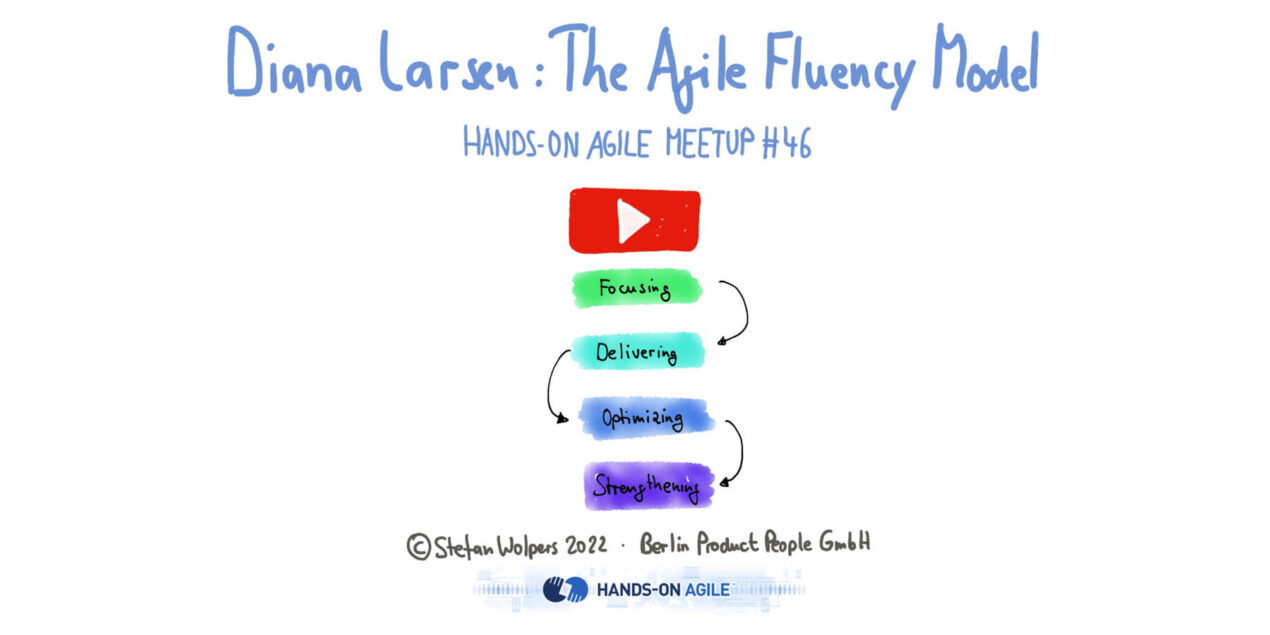TL; DR: Hands-on Agile #46: Engage the Agile Fluency® Model with Diana Larsen
On October 12, 2022, agile innovator Diana Larsen delved into the Agile Fluency® Model. After a short introduction to the model, we shifted to an ask-me-anything-style discussion of the groundbreaking view of agile and teams.
📺 Watch the video now: Engage the Agile Fluency® Model with Diana Larsen — Hands-on Agile #46.
🇩🇪 Zur deutschsprachigen Version des Artikels: Das Agile Fluency® Modell — Diana Larsen auf dem 46. Hands-on Agile Meetup.
🗞 Shall I notify you about articles like this one? Awesome! You can sign up here for the ‘Food for Agile Thought’ newsletter and join 36,000-plus other subscribers.
🎓 Join Stefan in one of his upcoming Professional Scrum training classes!
🖥 💯 🇬🇧 Advanced Professional Scrum Master Online Training w/ PSM II Certificate — December 12-13, 2022.
📈 Let Us Create Transparency—join 925-plus peers: Join the Anonymous Scrum Master Salary Report 2023.
The Agile Fluency® Model
The Agile Fluency® Model is based on four zones reflecting a team’s progress in becoming agile. Quote:
- Focusing teams produce business value.
- Delivering teams deliver on the market cadence.
- Optimizing teams lead their market.
- Strengthening teams make their organizations stronger.
Each zone depends on a set of agile proficiencies. A proficiency is an observable behavior—such as “The team works with a business representative who provides the team with the business's perspective and expectations”—that leads to the zone’s benefits.
In the Agile Fluency Model, we’re most interested in fluent proficiency: a habit of exhibiting the proficiency at all times, even when under pressure. Anyone can follow a set of techniques when given time to focus in a classroom; true fluency is skillful, routine ease that persists when your mind is distracted with other things.
Source: The Agile Fluency Model.
Watch the recording of Diana Larsen’s talk on the Agile Fluency® Model now:
Diana Larsen’s slides on the Agile Fluency® Model are available on Slideshare:
Q&A Session on the Agile Fluency® Model
During the Q&A session, Diana answered the following questions from attendees:
- Thomas Rickal: [I have a] Question for understanding - organizations should select the zone they want to invest in based on the benefits they want to get. You do not have to start with Focusing, then Delivering, and so on. Correct? What if the delivery team does not want to take shared responsibility?
- Badr: The company I work in seems to be very good at optimizing and good delivering but not focussing well. Do zones always follow each other? Do you have experience with organizations working “backward?”
- Ana Lopez: For teams that can't allocate 100% of the time, should the business then take that as an indicator that they need to hire more people?
- Max: Thank you so much, Stefan and Diana! Does [the Agile Fluency® Model] apply to any delivery context? Even within operations? Any examples?
- Max: How is the Agile Fluency® Model related or not to SAFe®?
- Scott: Does the inability of large organizations to be able to move into the Strengthening level of the model hold them back and allow startups to compete with them more easily? Does it also mean that large organizations are less suited to address societal concerns?
- Gabe: How would you apply the model to an underperforming team (that has supposedly gone past a stage on the fluency model)?
- Pari: Do you suggest any optimization index for IT companies, or can we not say something in general?
(Please note that the questions have been slightly edited to improve legibility.)
Diana Larsen
The agile community knows Diana Larsen for her contributions to the foundations and extensions of Agile thought and practices. As a consulting partner, mentor, and speaker, she’s worked with forward-looking leaders throughout her career.
Diana co-authored several influential books: Liftoff: Start and Sustain Successful Agile Teams, 2nd ed. gives clear instructions for chartering and setting a tone for productive teamwork. In Five Rules for Accelerated Learning, leaders find guidance for supporting more effective learning. Agile Retrospectives provides a framework for team learning and improvement. (2nd edition coming later in 2022!) The Agile Fluency® Model: A Brief Guide to Success with Agile is available as a free eBook.
The past year she provided content for James Shore’s The Art of Agile Development, 2nd edition.
Also, check out Diana’s latest book, co-authored with Tricia Broderick: Lead without Blame: Building Resilient Learning Teams.
Connect with Diana Larsen
📺 Join 4,000-plus Agile Peers on Youtube
Now available on the Age-of-Product Youtube channel to improve learning and help your team to use the Agile Fluency® Model:
- 🆕 Hands-on Agile 46: The Agile Fluency Model ® with Diana Larsen.
- 🆕 Hands-on Agile 45: FAST: An Innovative Way to Scale with James Shore.
- Hands-on Agile 44: Honey, I Shrunk the Backlog with Allan Kelly.
- Hands-on Agile 43: Outcome-Based Product Planning with Jeff Gothelf.
- Hands-on Agile 42: Lean Roadmapping and OKRs with Janna Bastow.
- Hands-on Agile 38: The Product Owner with Roman Pichler.
📖 Related Posts
The Agile Fluency® Model eBook
Agile Movers & Shakers (2): Diana Larsen.
Agile Audit: How Is Your Agile Transition Progressing?.
Download the free Scrum Anti-Patterns Guide.
Download the free Scrum Guide 2020 Reordered to understand patterns.
📅 Scrum Training Classes, Workshops, and Events
Delve into understand Scrum with our Scrum training classes, workshops, and events. You can secure your seat directly by following the corresponding link in the table below:
See all upcoming classes here.
You can book your seat for the training directly by following the corresponding links to the ticket shop. If the procurement process of your organization requires a different purchasing process, please contact Berlin Product People GmbH directly.
✋ Learn More About the Agile Fluency® Model — Join the 12,000-plus Strong ‘Hands-on Agile’ Slack Community
I invite you to join the “Hands-on Agile” Slack Community and enjoy the benefits of a fast-growing, vibrant community of agile practitioners from around the world.
If you like to join all you have to do now is provide your credentials via this Google form, and I will sign you up. By the way, it’s free.
Support your team in the use of Scrum tools and the Agile Fluency® Model by pointing to the free Scrum Anti-Patterns Guide:







